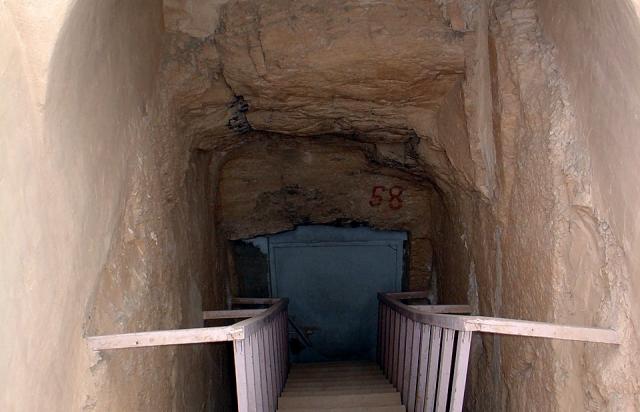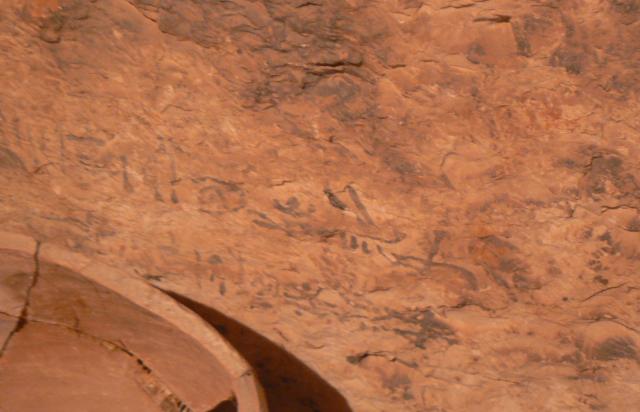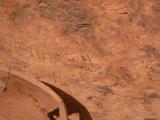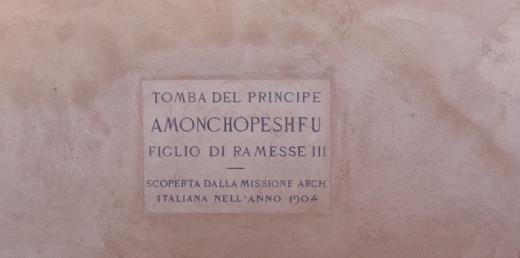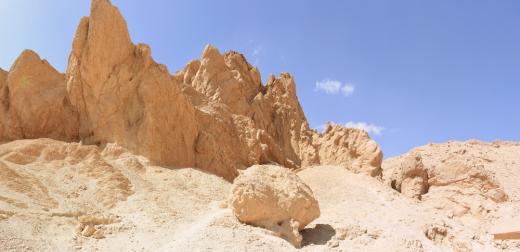QV 58
Anonymous
Entryway A
See entire tombA stepped Ramp with modern arched cover and masonry walls provides access to this tomb. Wooden stairs with handrails have been installed over the original stepped ramp. There are remains of plaster infill on the wall of the entry ramp. Above the entrance door, there is a vertical fracture in the rock Overhang on the west and another fracture on the east of the overhang that has been filled with modern repair mortar.
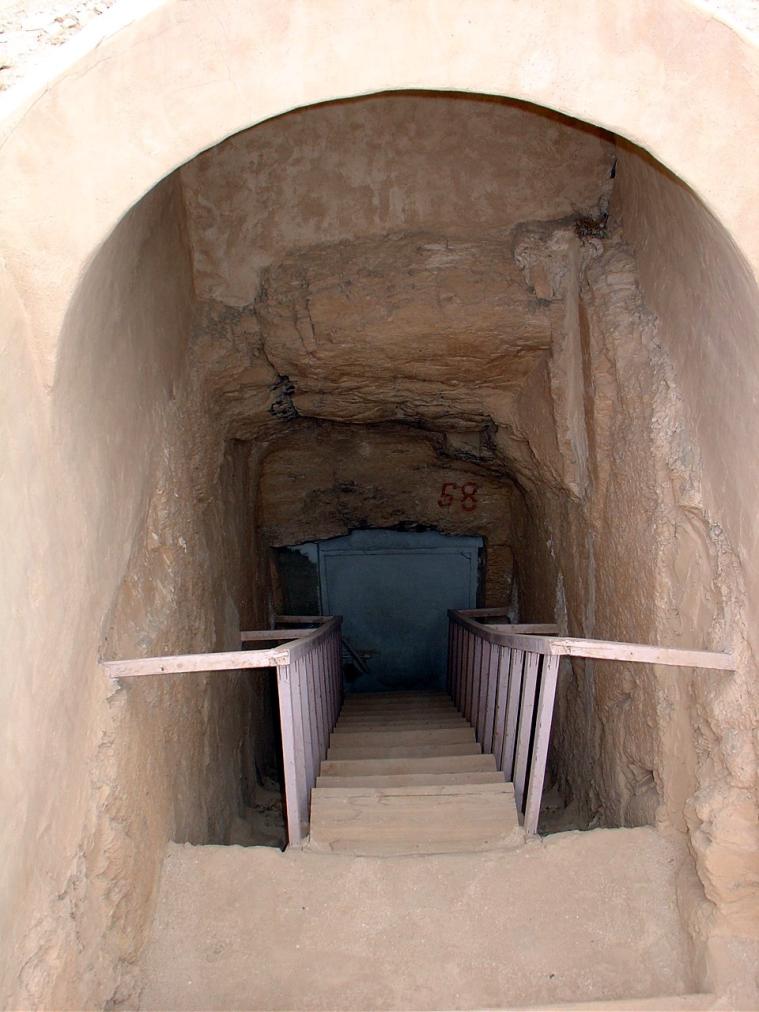
Gate B
See entire tombThis gate provides access to the tomb and an exterior metal door without ventilation holes prevents entry. There are mason's marks still visible in red ink at the tomb entrance. There is recent localized rock loss in the doorway due to the construction of a modern surround.
Chamber B
See entire tombThis chamber lies perpendicular to the axis of the tomb's entrance. There are three side chambers off of this main chamber, two to the north and one to the east. Small areas of mouna plaster survive on the walls and a later Hieratic inscription is visible on the south wall. The walls and ceiling are blackened from fire. The lower parts of the walls seem to have been protected against the fire by debris or sand. There is a North-south fracture in the ceiling with an area of recent loss near gate B. Localized loss of rock at the base of the walls and an apparent water line about 0.5m high indicates that the tomb flooded in the past.
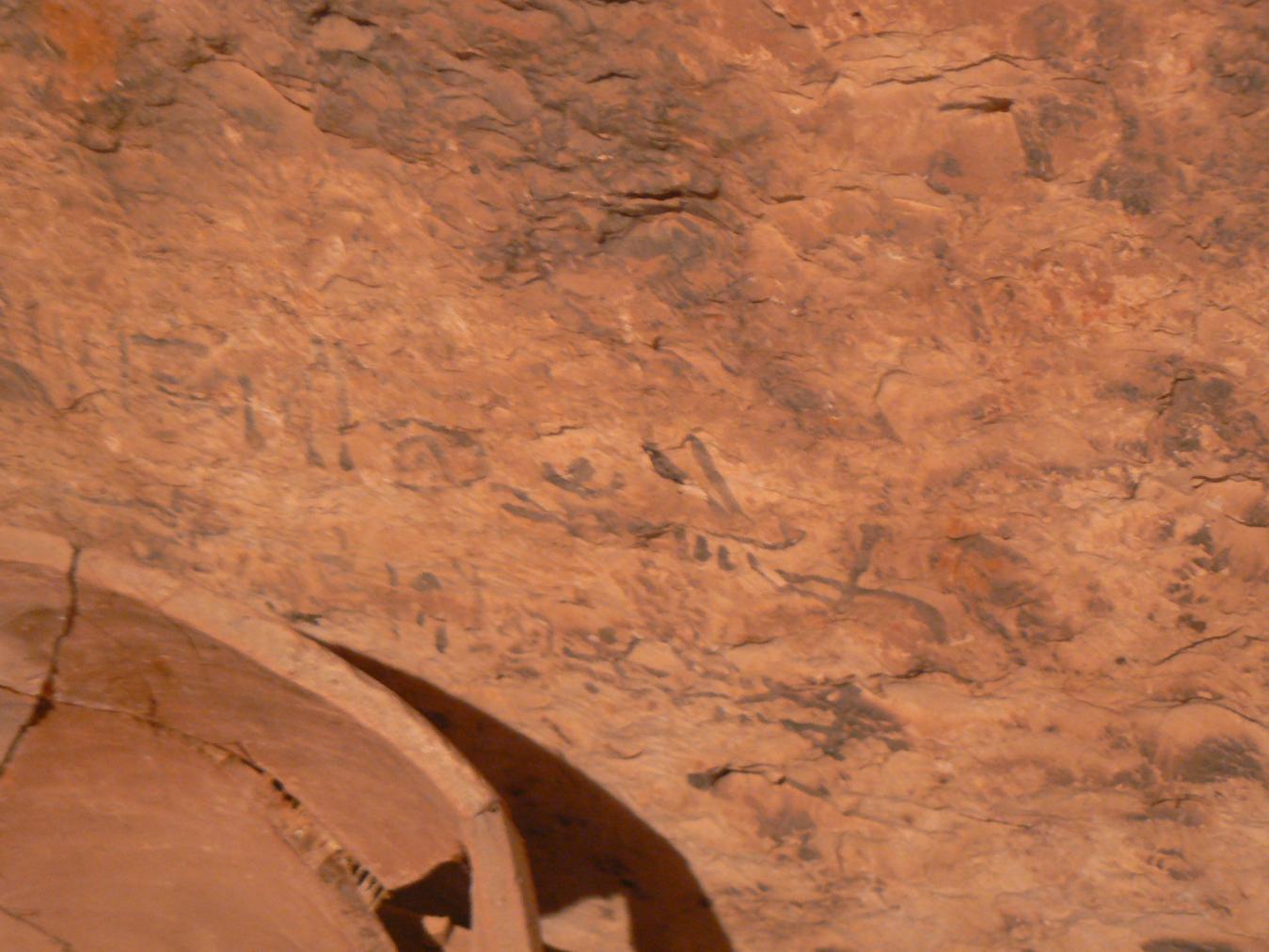
Gate Ba
See entire tombThis gate is cut into the northern wall of chamber B on its western side and provides access to a side chamber. As the tomb is currently used for storage, a modern door has been installed in the gate with door surrounds constructed of fired brick. Small areas of mouna plaster remain in the doorway.
Side chamber Ba
See entire tombThis side chamber lies to the north of the main chamber on its western side. The ceiling in this side chamber has numerous fractures, mostly parallel and in an East-West orientation, and there are fallen and settled wedges of rock between the fractures. Lighting and shelving were installed inside this chamber by the CNRS for storage of materials from the Valley of the Queens and the Ramesseum.
Gate Bb
See entire tombThis gate is cut into the northern wall of the main chamber on its eastern side and provides access to a side chamber. As the tomb is currently used for storage, a modern door has been installed in the doorway with door surrounds constructed of fired brick. Recent localized rock loss has occurred in the doorway due to the construction of the modern door.
Side chamber Bb
See entire tombThis side chamber lies to the north of the main chamber at its eastern end. The walls and ceiling are blackened by fire and the ceiling has numerous fractures, mostly parallel and in an East-West orientation, and have fallen and settled wedges of rock between the fractures. Lighting and shelving in were installed inside this chamber by the CNRS for the storage of materials from the Valley of the Queens and the Ramesseum.
Gate Bc
See entire tombThis wide gate lies at the northeastern end of the main chamber and provides access to a large side chamber. As the tomb is currently used for storage, a modern door has been installed in the gate with door surrounds constructed of fired brick.
Side chamber Bc
See entire tombThis side chamber lies to the east and its axis is perpendicular to that of the main chamber. A protrusion at ceiling level of the southwestern wall may possibly be the remains of a door jamb. The walls and ceiling are blackened from fire and the ceiling has numerous fractures, mostly parallel and in an East-West orientation, and has fallen and settled wedges of rock between the fractures. Lighting and shelving were installed inside this chamber by the CNRS for the storage of materials from the Valley of the Queens and the Ramesseum. There is a pile of large rock fragments on the floor of this chamber, but it is unclear where they are from as the ceiling does not have a significantly large area of loss.
Gate Bca
See entire tombThis gate is cut into the northeastern wall of side chamber Bc and provides access to a small side chamber or niche. It is undecorated and blackened from fire.
Side chamber Bca
See entire tombThis small side chamber or niche lies to the northeast of side chamber Bc. It is undecorated and the walls are blackened from fire.
About
About
QV 58 is located low in the main Wadi, south of QV 57 and underlying the ancient workers huts. The tomb is entered through a stepped Ramp (A) leading to chamber (B) with three side chambers (Ba, Bb, Bc). Side chambers (Ba) and (Bb) are located north of chamber B and parallel to each other. A wide doorway at the eastern side of chamber B continues to a large side chamber (Bc). A niche or unfinished small chamber (Bca) is located off chamber (Bc). The tomb is oriented on a north-south axis deep below the surface, similar to QV 80 and QV 66. As the tomb is currently used for storage, modern doors have been installed in three of chamber B's doorways, with door surrounds constructed of fired brick. Walls and ceilings are blackened throughout the tomb. Small areas of mouna plaster remain in chamber (B) and the doorway leading to chamber Bb, and a Hieratic inscription survives in chamber (B).
Robert Hay of Linplum (1826), who recorded the tomb as being empty except for some bones, and Jean Francois Champollion (1829) both visited the tomb. According to Christian Leblanc, director of the Franco-Egyptian Mission, this unfinished 19th Dynasty tomb was reused in the Third Intermediate and Roman periods for burial and was possibly accessible in the Arab period. Elizabeth Thomas (1959-60) also noted that the tomb appeared to have been accessible for a long period. She further observed that the tomb was well cut, as indicated by mason's marks still visible in red ink at the tomb entrance and remains of plaster infill on the wall of the entry ramp. The tomb was last cleared in 1981-83 by the Franco-Egyptian Mission and is currently being used as a magazine for archaeological study materials by the CNRS and SCA, containing artifacts from Valley of the Queens and the Ramesseum. Three wooden doors, lighting, and shelving in side chambers (Ba, Bb, Bc) were installed by the CNRS. Ramp (A) has an arched cover, wooden stairs with handrails installed over the original stepped ramp, and an exterior steel door without ventilation holes at the base of the ramp.
Site History
The tomb was constructed in the 19th Dynasty and reused during the Third Intermediate Period. It was also reused during the Roman Period, specifically during the reign of Flavius, as demonstrated by mummies with plastrons and terracotta sarcophagi with likenesses in relief. The tomb seems to have been open during the Arab period and the tomb and its contents were completely burnt, perhaps as purification.
Dating
This site was used during the following period(s):
Exploration
Conservation
Conservation History
A fracture on the east of the Overhang has been filled with modern repair mortar. Modern shelving and lighting were also installed by the Franco-Egyptian Mission in side chambers Ba, Bb, and Bc and the doors to these chambers were rebuilt.
Site Condition
According to the GCI-SCA, above the entrance door deep below the surface there is a vertical fracture in the Overhang on the west, and another fracture on the east of the overhang that has been filled with modern repair mortar. The ceilings in all four chambers have numerous fractures, mostly parallel and in an East-West orientation, with fallen and settled wedges of rock between the fractures. However, none of the major losses or damage is pre-fire, as all rock surfaces except the bases of walls in entrance chamber (B) are blackened. The only recent localized rock losses, in the main entrance doorway and just inside Gate (Bc), are due to the construction of modern doors. There is a pile of large rock fragments on the floor of chamber (Bc), but it is unclear where they are from as the ceiling in this chamber does not have a significantly large area of loss. Overall, however, the rock of this tomb is stable. There is evidence of past bat activities in the tomb, but no bats were sighted during the GCI-SCA assessment. The factors contributing to the major losses and fractures in chamber ceilings in the distant past are the natural weaknesses of the tilted marl block and possibly flooding. An apparent water line about 0.5m high on its walls also appears to indicate past impact by flood. The location of the tomb opening in a low lying position within the main valley puts the tomb at high risk of future flooding.







Articles
Tomb Numbering Systems in the Valley of the Queens and the Western Wadis
Geography and Geology of the Valley of the Queens and Western Wadis
Bibliography
Demas, Martha and Neville Agnew (eds). Valley of the Queens. Assessment Report. Los Angeles: The Getty Conservation Institute, 2012, 2016. Two vols.
Leblanc, Christian and Fathi Hassanein. La Vallée des Reines. Archéologia 205 (1985): 28-29.
Leblanc, Christian. Les tombes no. 58 (anonyme) et no. 60 (Nebet-taouy) de la Vallée des Reines (rapport préliminaire). Annales du Service des antiquités de l’Egypte 69 (1983): 29-52.
Leblanc, Christian. Thèbes et les pluies torrentielles: à propos de mw n pt. Memnonia, 6 (1995): 197-214.
Leblanc, Christian. Western Thebes and the Queens of the Two Lands in the New Kingdom. In: Kent R. Weeks (Ed.). The Treasures of the Valley of the Kings: Tombs and Temples of the Theben West Bank in Luxor. Cairo: The American University in Cairo Press, 2001: 272-93.
Leblanc, Christian. Les tombes no. 58 [anonyme] et no. 60 [Nebet-taouy] de la Vallée des Reines: achèvement des dégagements et conclusions. Annales du Service des antiquités de l'Egypte 70 (1984-1985): 51-68 pl. I-II.
Thomas, Elizabeth. The Royal Necropoleis of Thebes. Princeton: privately printed, 1966.

